| Rise of the Dragon:
China’s Dreadnoughts
By Mike Bennighof, Ph.D.
January 2024
 Even as China’s Imperial Navy made great strides toward modernization in the last decades of the 19th Century, repeated disasters wiped out the progress. Naval wars with France in 1884 and Japan in 1894 destroyed many of China’s newest warships, yet the Celestial Empire continued to strive to join – and then overtake – the more modern world powers. Even as China’s Imperial Navy made great strides toward modernization in the last decades of the 19th Century, repeated disasters wiped out the progress. Naval wars with France in 1884 and Japan in 1894 destroyed many of China’s newest warships, yet the Celestial Empire continued to strive to join – and then overtake – the more modern world powers.
Japan’s smashing victory over Russia in 1905 provided even more incentive for Chinese naval modernization. On the one hand, the Japanese had proven that an Asian nation could defeat a European great power. On the other, the growth of Japanese power represented a serious threat to Chinese interests and even independence. For both reasons, the Prince-Regent’s advisors urged creation of a modern fleet (actually, three of them, one for each traditional maritime sector).
The first proposal, made in 1907, centered on modern pre-dreadnought battleships and seems to have been sponsored by Japan’s Kawasaki Heavy Industries, which did substantial business in China and already was building gunboats and transports for the Imperial Chinese Navy. The Chinese began planning for three fleets, each built around one battleship, and surveyed new naval bases for them.
Word of Chinese naval revival brought shipyard salesmen from around the world to offer their products, and the Chinese soon realized that Kawasaki’s proposed battleships were already outdated. The world’s leading naval powers were building dreadnoughts, so China would build them too – which also meant greater commissions for those processing the orders, and greater kickbacks for those placing them.
In June 1909 the Regent, Prince Chun Zaifeng, directed his brother Prince Tsai-hsun along with Admiral Sah Chen-ping to implement plans for a modern Chinese navy. The two set off on a world tour, visiting shipyards and gun factories in Britain, France, Germany, Austria-Hungary, Russia, Italy, Japan and the United States. They apparently had a good time everywhere they travelled except for France. They spread new orders for destroyers and training cruisers to most of the countries they had visited, but laid down a directive that no ships would be purchased in France.
Revolution came in 1911, and the Imperial government would eventually be overthrown. The Republic’s leaders did not try to void the contracts for new warships and appear to have had an interest in continuing the program, but the shipyards balked at dealing with the unstable new regime. There would be no Chinese dreadnought program.
That doesn’t prevent us from adding those ships that never were to Great War at Sea. Rise of the Dragon introduces the ships that China would have purchased together with scenarios so you can play with them.
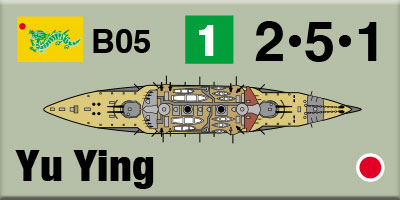
China actually became a player in the world battleship market in 1904, making an offer to buy the two former Chilean battleships Libertad and Constitucion from their British builders, as well as other incomplete ships in a number of nations. It’s not clear for whom the Chinese were fronting, but the ships do not appear to have been intended for their own fleet.
The Royal Navy most definitely did not want the ships, but ended up with them anyway. China could just as easily have been stuck with them. They were smaller than the usual pre-dreadnought, slightly faster but weakly protected and carrying an outdated armament of 10-inch guns (for a higher rate of fire).
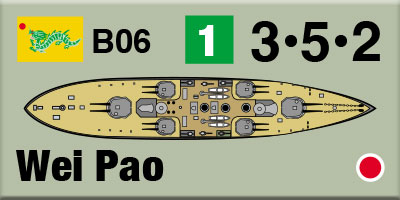
Kawasaki’s proposed pre-dreadnought battleships would have been based on the large armored cruiser Kurama, then under construction at Yokosuka naval dockyard. Japan had only just begun building its own heavy warships, and so far all had been laid down in naval dockyards rather than at private firms. Kawasaki hoped to change that, and the Chinese battleship order would prove the firm’s capabilities. The Chinese ships would have been about the same size as Kurama’s 15,000 tons, but feature better protection.

Germany’s AG Vulkan yard designed a powerful coast-defense ship for Greece, but the Greeks changed their minds and went with a full-sized dreadnought instead. Vulkan offered the design to other nations without any takers, but the ship would have met Chinese requirements before their own switch to a dreadnought preference. Plus Vulkan had a long relationship with the Chinese navy. Huang Ch’eng carries six American-made 14-inch guns and sports good protection, making her a deadly opponent for enemy battleships venturing too close to shore. But this wasn’t what the Chinese wanted any more.
The Chinese program approved in 1909 featured eight new dreadnought battleships and 20 cruisers. The orders would have been spread around the world, reflecting both Chinese policy and the desire of Prince Tsun and Admiral Sah to reward those who had entertained them well. Just which yards would have received the orders is pretty much guesswork, but we can make some education guesses.

Bethlehem Steel made the strongest push for Chinese business of all the yards visited, and would probably have been the most likely to benefit from the effort. Bethlehem Steel provided the armor, structural steel and guns for the two dreadnoughts built for Argentina by Fore River Shipyard (one was sub-contracted to another firm), and the Chinese Hai Lung class in Rise of the Dragon is built to a similar design. The Rivadavia class carried a dozen 12-inch guns in six dual turrets, with four of the guns in less-efficient wing turrets.

Austria-Hungary’s Stabilimento Technico Triestino also made a good impression on the Chinese delegation, and another Trieste firm, Cantiere Navale, would be the only shipyard to actually receive orders for first-line cruisers (as opposed to training ships) from the Chinese. STT’s chief designer at the time, Siegfried Popper, had designed the Tegetthoff class for the Imperial and Royal Navy while employed by the government, but had come to believe the ships over-armed with a dozen 12-inch guns. They should have had only 10 such guns to reduce hull strain, Popper argued, and he sketched such a ship for the Imperial and Royal Navy. That’s probably the design STT would have offered to the Chinese, and it’s the Austrian-built class included in Rise of the Dragon.
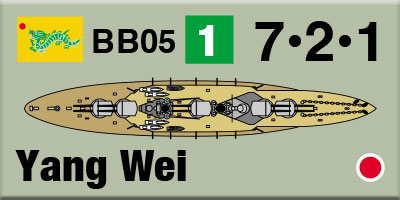
AG Vulkan had built the Imperial Chinese battleships lost during the Sino-Japanese War, and continued to have a close relationship with China. Vulkan built the dreadnought Rheinland for the High Seas Fleet, but afterwards built only cruisers for the German Navy and passenger liners (Vulkan built the Greek dreadnought Salamis as well). The yard had the means and desire to build more dreadnoughts, and a Chinese order would have been very welcome. Vulkan sought more Chinese business, and built a number of gunboats. The Yang Wei class of Chinese dreadnoughts is based on the König class of the High Seas Fleet, armed with ten 12-inch guns in five turrets mounted along the centerline.
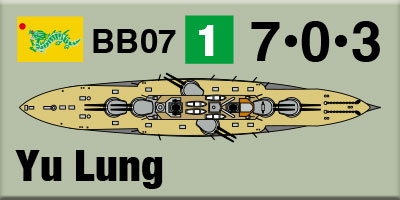
Britain’s Armstrong-Vickers combine also bid strongly for Chinese battleship business, arranging for Admiral Sah to receive a knighthood as part of their bribery campaign. Armstrong and Vickers each built one of the three training cruisers ordered by the Chinese, and likely would have each received a battleship as well had the program advanced to that stage. The British entries for the Chinese fleet are close cousins of the Brazilian Minas Geraes, also built at Armstrong and Vickers. They carry a dozen 12-inch guns, but four of them are in wing turrets.
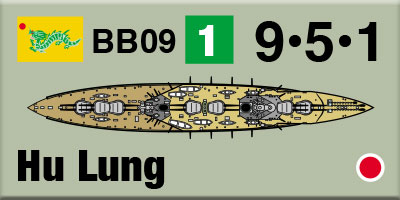
Brazil also laid down a third dreadnought, Rio de Janeiro, but offered her for sale when world coffee prices collapsed. Many naval powers attempted to acquire her (or to buy her before a rival could do so), with Ottoman Turkey emerging with the ship after a flurry of back-room bribes, counter-bribes and general skullduggery. China did not enter the competition, but likely would have had she been in the market for dreadnoughts. And since we’ve already shown the ship in a countless array of national colors in various Great War at Sea supplements (British, Turkish, Brazilian, Greek, Austrian, Italian, Romanian, Japanese, Russian, Confederate, Danish, Dutch, Canadian, Mexican, Spanish, American, French) we can’t miss an opportunity to add one more.
You can order Rise of the Dragon (second edition) right here.
Prince Chun’s Dreadnoughts
Russo-Japanese War (Playbook)
Rise of the Dragon (2e)
Retail Price: $99.98
Package Price: $80.00
Gold Club Price: $64.00
You can order Prince Chun right here.
Sign up for our newsletter right here. Your info will never be sold or transferred; we'll just use it to update you on new games and new offers.
Mike Bennighof is president of Avalanche Press and holds a doctorate in history from Emory University. A Fulbright Scholar and NASA Journalist in Space finalist, he has published a great many books, games and articles on historical subjects; people are saying that some of them are actually good.
He lives in Birmingham, Alabama with his wife, three children, and his new puppy. His Iron Dog, Leopold, could swim very well.
Want to keep Daily Content free of third-party ads? You can send us some love (and cash) through this link right here.
|
